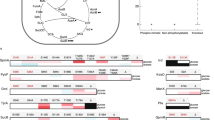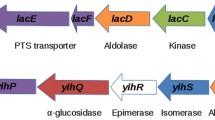Abstract
The mechanisms controlling the biosynthesis and degradation of l-serine and l-threonine are remarkably complex. Their metabolism forms a network of pathways linking several amino acids, central primary metabolites such as pyruvate, oxaloacetate and 3-phosphoglycerate, and C1 metabolism. Studies on the degradation of these amino acids in Escherichia coli have revealed the involvement of fascinating enzymes that utilise quite diverse catalytic mechanisms. Moreover, it is emerging that both environmental and metabolic signals have a major impact in controlling enzyme synthesis. This is exemplified by the anaerobically regulated tdc operon, which encodes a metabolic pathway for the degradation of serine and threonine. Studies on this pathway are beginning to provide insights into how an organism adapts its genetic makeup to meet the physiological demands of the cell.
Similar content being viewed by others
Author information
Authors and Affiliations
Additional information
Received: 30 August 1998 / Accepted: 9 October 1998
Rights and permissions
About this article
Cite this article
Sawers, G. The anaerobic degradation of l-serine and l-threonine in enterobacteria: networks of pathways and regulatory signals. Arch Microbiol 171, 1–5 (1998). https://doi.org/10.1007/s002030050670
Issue Date:
DOI: https://doi.org/10.1007/s002030050670




